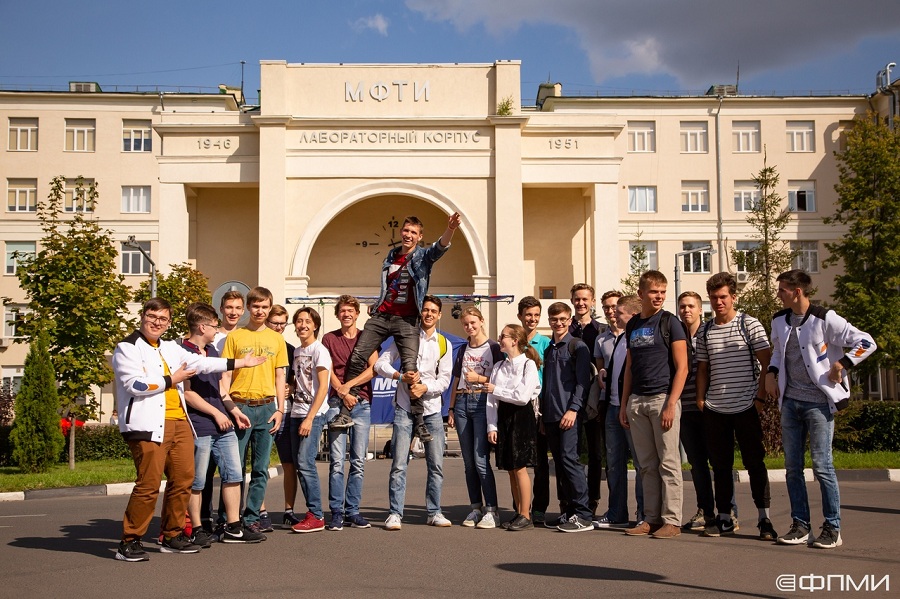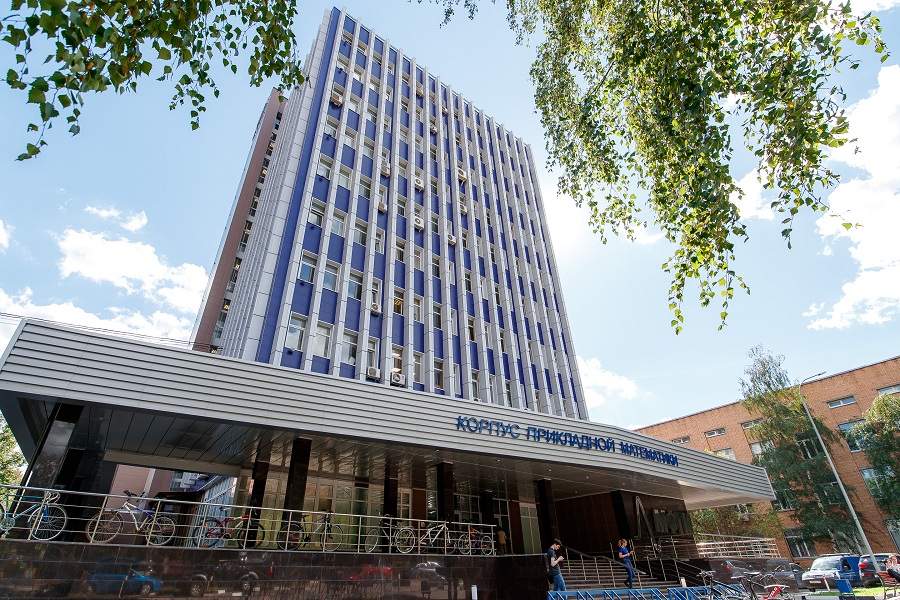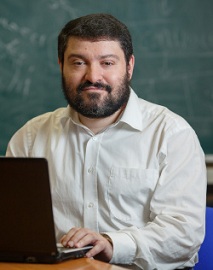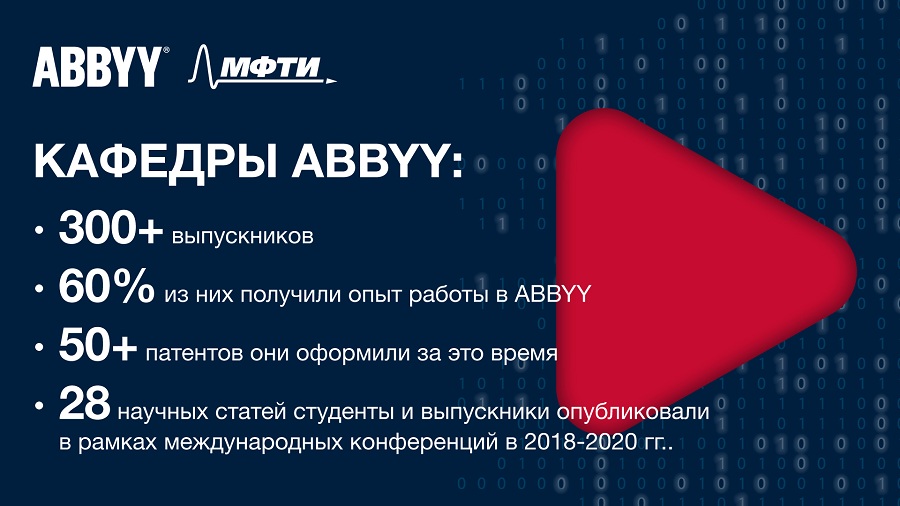
FPMI freshmen against the backdrop of the most popular MIPT building for joint photographs.
Formally, FPMI is young. But already very wise. Let us explain: the Physicotechnical School appeared in 2016, combining the Faculty of Innovation and High Technologies ( FIVT ), created in 2006, and the Faculty of Management and Applied Mathematics ( FUPM ), opened more than 50 years ago.
Many famous people graduated from these faculties, which became the basis of FPMI. Let's list some of them:
- Sergei Guriev , economist, former rector of NES.
- Maxim Potashev , master of the game “What? Where? When? ”, Four-time winner of the“ Crystal Owl ”prize, President of the Russian Sports Bridge Federation.
- Konstantin Vinogradov , senior investment manager of the venture fund Runa Capital and a graduate of the data analysis department. Member of last year's Forbes 30 to 30 list .
- Victor Kantor , Head of Machine Learning at MTS. This year he was included in a similar rating for Forbes. You can read a fresh interview with him here .
Among very young stars:
- Yuri Garnov, founder of the startup TimeAdge. You can read an interview with him here .
- Ivan Glushenkov is the founder of the popular Russian Hackers community of developers , co-founder of the Phystech Genesis hackathon organization company , multiple winner and prize-winner of international and Russian hackathons.
As you can see from the examples above, many students find work in their specialization or become entrepreneurs as early as 3-4 years of age and become in demand before receiving a diploma. Some graduate students receive relocation offers from the largest IT companies and combine their studies with an international career.
How is FPMI different from other Phystech schools? The Phystech School of Applied Mathematics and Informatics specializes in education and research in the area of convergence of mathematics, physics, programming and computer science. This combination allows us to offer our applicants a choice from a large number of programs and departments in a variety of areas.
More than 460 freshmen are admitted to the FPMI every year, most of them go to budget places. 90% of those who graduate from the bachelor's degree remain in the master's degree This year, about 470 students enrolled in the master 's program , and about 73 in graduate school. In total, FPMI has more than 50 master's programs in five main areas: machine learning, programming, mathematics, physical modeling and economics / consulting.
The Phystech School has 30 base departments of various research centers ( MIAN RAS , IITP RAS , ISP RAS , FRC IU RAS , etc.) and partner companies, for example, ABBYY, Yandex, SberTech, Huawei, Tinkoff, S7 Group and others. With their support, 21 scientific laboratories have been created... In total, 2,450 students study at the FPMI, which is one third of the total number of students at Phystech.

The Corps of Applied Mathematics (KPM) , where almost all the school departments of FPMI are located.
In FPMI, students and their research work are supported by a variety of scholarships . In addition to the state, there is a grant from the president, an Abramov scholarship, as well as support from partner companies. For example, this year ABBYY established a scholarship to encourage research in multimodality and social media analysis. By the way, you can still apply for this grant before September 27, details can be found here .
So, and, it seems, we have not yet mentioned the main thing. Phystech School of Applied Mathematics and Informatics is headed byAndrey Mikhailovich Raigorodsky , Doctor of Physics and Mathematics, Professor, Laureate of the Prize of the President of Russia, Head of two laboratories and one department.

A.M. Raigorodsky - to students: "Bot, my friends, bot!"
“I am happy when I see how actively and vividly we grow and develop, how together we are doing a unique business. I wish you all success in your studies, in Olympiads, in projects, in science. Come to us!"
What the ABBYY Chairs Really Do
Two departments of FPMI were created together with ABBYY: the Department of Computational Linguistics ( CL ), which was opened 9 years ago, and the Department of Image Recognition and Text Processing ( RIOT ), which has existed for 14 years. Why did these chairs appear? Our goal is to find talented guys with innovative thinking and develop their abilities. In the future, they will tackle complex and ambitious tasks that have never been solved before. And it is possible that these guys will work in ABBYY.
Both ABBYY departments are located on the company's premises... Here the guys both study and participate in internships and company projects in order to gain experience necessary for further work. It is also convenient for our employees who teach: they do not need to waste time traveling from the institute to work and back. And ABBYY's office is not so far from Dolgoprudny, where Phystech is located.

Results of the work of the ABBYY departments.
* 20 patents registered in the United States.
Our student, at that time a fourth-year student, spoke on Habré in March about how this year the recruitment to the ABBYY departments and how the training was organized,Alexey__Petrov... You can read about his impressions in this post . For those who want even more information, we recommend a video from the presentation of ABBYY departments . You will learn not only about the educational process, but also about the career stories of several of our employees.
This year, 137 students applied for our bachelor's degree programs, and as a result of competitive tests, 28 of them entered. They will start studying at the department next year, in the spring semester. In total, the training will last 1.5 years. Here's what the guys say about choosing a department:
 Timur and Artem Nurgalievs, department of CL :
Timur and Artem Nurgalievs, department of CL :
Timur: “My brother and I have been together since childhood: we studied in the same class, then in the same group, and now we will study at the same department. When I entered MIPT, I wanted to do science, but I was hooked on programming more. At the same time, for me a necessary condition in my future profession is the opportunity for creativity. So in a few years I can quite combine technology with drawing cartoons or a blogging career! "
Artem: “When everyone was choosing the department, my brother and my friend and I created a common document in which everyone wrote down the criteria for the assessment. In the process, we carefully evaluated all the departments together, and the ABBYY departments won. I would like my work to be useful, and I hope that this is where ABBYY and I have a lot in common. I love programming because it opens up opportunities to create something different. When you combine that with a dose of creativity and luck, you can achieve a lot! "
 Roman Galkin, Department of RIOT : “The ABBYY Department is one of the few where you can immerse yourself in the field of computer vision at the bachelor's degree. This became a key factor in choosing. Now I am most interested in machine learning, I want to delve into Computer Vision. In the future, I want to launch a product based on machine learning. Among business ideas, there are those where imaging and video skills are needed. I hope the knowledge that I get at the department will help me with this! "
Roman Galkin, Department of RIOT : “The ABBYY Department is one of the few where you can immerse yourself in the field of computer vision at the bachelor's degree. This became a key factor in choosing. Now I am most interested in machine learning, I want to delve into Computer Vision. In the future, I want to launch a product based on machine learning. Among business ideas, there are those where imaging and video skills are needed. I hope the knowledge that I get at the department will help me with this! "
The master's degree in the departments of ABBYY this year applied for 46 students, including 18 children came to us.
 Nikita Chestnov, 5th year student, department of RIOT : “Before entering the department of RIOT, I studied at the department of laser systems and structured materials (Phystech School of Physics and Research named after Landau). I chose ABBYY's Master's degree because it is the best place to participate in leading research in computer vision.
Nikita Chestnov, 5th year student, department of RIOT : “Before entering the department of RIOT, I studied at the department of laser systems and structured materials (Phystech School of Physics and Research named after Landau). I chose ABBYY's Master's degree because it is the best place to participate in leading research in computer vision.
I would like to immerse myself in research and become a computer vision specialist. Now I'm interested in the NAS problem (Neural Architecture Search) in the CV domain. This direction makes it possible to design neural networks much more efficiently, which is why they are better at coping with the assigned tasks than those designed by humans. "
 Ksenia Klokova, 5th year student, department of CL : “I received an education in economics, but some time after graduating from my bachelor's degree I realized that I wanted to develop in data science. I have always been interested in language as a phenomenon and processing of textual information, and that is why I began to read various articles and conduct experiments. As a result, I decided that I wanted to build a scientific career in the field of computational linguistics. Studying at the department is an opportunity to move towards this goal and learn from the best specialists and scientists.
Ksenia Klokova, 5th year student, department of CL : “I received an education in economics, but some time after graduating from my bachelor's degree I realized that I wanted to develop in data science. I have always been interested in language as a phenomenon and processing of textual information, and that is why I began to read various articles and conduct experiments. As a result, I decided that I wanted to build a scientific career in the field of computational linguistics. Studying at the department is an opportunity to move towards this goal and learn from the best specialists and scientists.
Now I work as a product analyst in the bank's customer service team. We are actively introducing various systems for processing textual information, so in the future I can be engaged in the development of new applied solutions and at the same time develop a scientific career. I'm interested in semantic parsers and the possibility of using information from semantic representations in machine translation. "
Among our graduates there are those who studied at the ABBYY department, worked with us, and then moved to larger international IT companies. For example, our graduate and former colleague Igor Kholopov graduated from the Department of RIOT, at ABBYY he went from junior to senior developer, and now he is engaged in cloud technologies at Google in Europe. Natasha Bolobolova also joined the American giant, before that she studied at the RIOT department. Alexey Zhuravlev, a graduate and postgraduate student of the RIOT department, a former head of the Computer Vision Research group at ABBYY and the author of two patents, now works for company X. Sounds mysterious, but the company is so cool that we will not reveal it yet.
Let's get some chemistry in ABBYY Lab

The building of Phystech. Tsifra, where most of the FPMI laboratories are located , including ABBYY Lab
We at ABBYY pay great attention to the direction of research and development. The company invests more than 25% of all R&D costs in research in the field of natural language processing and computer vision. This is necessary in order to develop sophisticated knowledge-intensive technologies that bring real benefits to companies in different industries and people around the world.
That is why, in 2019, on the basis of FPMI, we created the ABBYY Lab. There, MIPT students and staff are engaged in cutting-edge developments in natural language processing and image analysis and research the latest methods of data analysis.
What tasks are the laboratory staff involved in?
- (, , );
- ;
- ;
- ;
- ;
- ;
- ;
- ;
- ;
- : , , .
ABBYY Lab ?
- ;
- ;
- - ;
- .
 The laboratory is headed by Alexander Zhukovsky, head of the Computer Vision Research Group at ABBYY .
The laboratory is headed by Alexander Zhukovsky, head of the Computer Vision Research Group at ABBYY .
Alexander : “Despite the pandemic, we spoke at several international conferences: the 26th International Conference on Computational Linguistics and Intelligent Technologies Dialogue , as well as the 14th IAPR International Workshop on Document Analysis Systems and the 17th International Conference on Frontiers of Handwriting Recognition . two conferences about document recognition, not so long ago separated from the main conference in the field - ICDAR . My colleague at ABBYY Lab recently participated in a workshop on modeling human natural articulation from speech and text -GENEA (Generation and Evaluation of Non-verbal Behavior for Embodied Agents) Workshop and got good results. "
If you still have questions about FPMI, ABBYY and ABBYY Lab departments, ask them in the comments! And also subscribe to the FPMI group on social networks and be the first to find out the latest news from the Physics and Technology School.
By the way, those who have graduated from FIVT, FUPM or already FPMI, tell us in the comments what you remember about studying at the Phystech School and what you would like to improve!